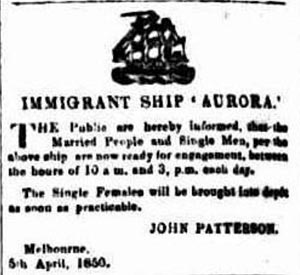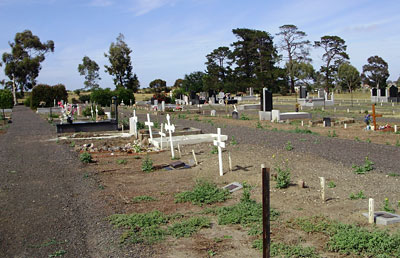James Dwyer (c.1821-1898) and Mary McRedmond (c.1834-1905)
Our great-great grandparents
James Dwyer was born in County Tipperary around 1821, the son of John Dwyer and Margaret Quirk. Mary McRedmond was born in Kings County (Offaly), probably close to the border with County Tipperary, in 1834, the daughter of Edward McRedmond and Jane Meagher. Nothing else is known of James and Mary before their emigration to the colony of Victoria in the 1850s.
James came to Victoria aged 29 years aboard the Aurora, a barque of 536 tons, which sailed from Plymouth on 27 December 1849 and arrived at Port Phillip on 31 March 1850, a voyage of 94 days. There were 214 immigrants aboard, along with a small number of cabin passengers and cargo including 70 hogsheads of beer, 1 case of cards, 11 cases of eau de Cologne and a quantity of sherry. James was listed among the single male passengers, along with a Matthew Dwyer and a Timothy Dwyer, and although all three were from County Tipperary, there is no indication that they were related. There was also a Catherine Dwyer from Solohead, County Tipperary listed among the single female immigrants but again there is no obvious connection with James.
Though the passage to Port Phillip was probably difficult, it appears that no immigrants died on the journey. A few weeks after landing, a number of passengers took out a newspaper advertisement to publicly thank the Surgeon Superintendent, J. Laffer Esq., “…for his strict attendance for promoting our health and comfort during the passage.” [Argus, Friday 12 April 1858, p.3]
Perhaps the experiences of Aurora’s crew were less positive. In the early morning of 5 April several of the crew attempted to jump ship while at anchor in Hobson’s Bay. One of them allegedly threatened the Captain, promising to “knock his brains out” if he tried to intervene. [Argus, Thursday 18 April 1850, p.2]
On that same day, 5 April 1850, the married people and single men aboard the Aurora were made available to local employers for engagement, a process that may have taken several days. Where and by whom James was employed is not known. He was brought out as an agricultural labourer, and his occupation was shown as “labourer” at his marriage in 1856, so we can assume that is how he was initially employed. By 1860 his occupation was given as carter, a carrier of goods by wagon, and when he died in 1898 he was a farmer.

Ad in The Argus April 1850.
There are three immigrants named Mary McRedmond arriving in Port Phillip, all of them in 1854:
- The first Mary McRedmond departed Southampton aboard the Wanata, a ship of 1443 tons, on 25 October 1853, arriving in Port Phillip on 23 January 1854, a voyage of 90 days. There were also an Ellen McRedmond aged 20 and a Julia McRedmond aged 18 listed. The Mary McRedmond aboard the Wanata was aged 26. All three were from Kings County, Roman Catholic and could read but not write. The fact that they all three went to Williamstown on arrival supports the notion that they were sisters or otherwise closely related.
- The second Mary McRedmond departed Liverpool aboard the Matoaka on 14 February 1854, arriving in Port Phillip on 26 May 1854, a voyage of 101 days. There were 403 immigrants aboard, including 306 adult women, and there were no immigrant deaths during the voyage. Mary was engaged as a domestic servant by a W. Brown of Leveson Street, North Melbourne. There was also a Margaret McRedmond listed among the immigrants, but since she was noted to have “Gone with friends” on arrival she and Mary may not have been closely related. Mary was noted as having been 20 years of age, from Kings County, a Roman Catholic and able to read but not write.
- The third Mary McRedmond departed Plymouth aboard the Phoebe Dunbar on 5 September 1854, arriving in Port Phillip on 25 December 1854, a voyage of 111 days. There were 270 emigrants aboard, including 201 adult women, one of whom and a female child died during the passage. Also aboard was a Daniel McRedmond aged 18. Mary, aged 20, is noted to have “Gone with Aunt Ann Inchcliffe [Hinchcliffe?], Smith St. Coll[ingwoo]d”, while Daniel was noted as “Gone with uncle, Smythe St. Collingwood”, strong evidence that they were brother and sister. The passenger record says that Daniel was from County Tipperary, while Mary was from Kings County, but this was probably either an error or an indication that they were from the area around the border of the two counties. Both were Roman Catholic and could neither read nor write.
Read some historical perspective on these ships.
In the record for her marriage to James Dwyer in January 1856 Mary’s age was given as 20 years, and her native place as County Tipperary. Although the age at marriage does not agree with any of the three immigrants’ details, it is probably enough evidence to discount the Wanata immigrant on the basis that she was too old to be the correct person. The link with County Tipperary for the Phoebe Dunbar immigrant probably makes this person the most likely to be the future wife of James Dwyer, although the Matoaka immigrant must also be considered a possibility.
As Irish Catholics James and Mary would have faced hostility and bigotry from established English and Scots settlers. This may have been apparent to them from the moment they stepped ashore. Mary’s first experiences on Australian soil might also have included the attentions of a group of the colony’s single males looking for a prospective wife. James Dwyer could have been among them.
By the beginning of 1856 James and Mary were both residents of Kalkallo, about 33 kilometers north of the city of Melbourne. Originally little more than a stopping place on the Sydney road one day’s journey from Melbourne, Kalkallo began to thrive with gold seekers passing through on the way to the northern diggings. By 1880, however, Kalkallo itself had become almost deserted. In part this may have been caused by the opening of a railway station at Donnybrook, about 2½ kilometers east of Kalkallo, in 1872. Read about their probable living conditions.
In 1856 James had a freehold house, but no farming land; he was a labourer and Mary a servant. They were part of a large Irish community in the Kalkallo/Donnybrook area. The present-day locality of Kalkallo has a “Dwyer Street” which may or may not have connections with the family of James and Mary. See photos of Dwyer Street in 2009.
James and Mary were married in St. Paul’s Roman Catholic Church, Pentridge (now Coburg) on 8 January 1856. Neither James nor Mary were able to sign their own names, and were noted as being a bachelor and spinster. Their age difference of around 15 years was somewhat unusual, although most women at that time in the Australian colonies married men at least 10 years their senior. One of the witnesses of the marriage was “R. Kennedy”, probably Roderick Kennedy (1820-1905) a prominent farmer of Kalkallo. Kennedy may have been James’ and also possibly Mary’s employer. The signature of the other witness is less clear; the name might be Mary Hadley or something similar.
Over the first half of their 42 year marriage, James and Mary produced nine children:
- Jane (1857-1864)
She died under tragic circumstances on 7 October 1864, aged 8 years. On an errand for her mother she drowned while crossing a flooded creek despite, according to Mary’s deposition at the coroner’s inquest, having been told to take the bridge. Details of Jane's death. - Mary (1858-1938)
She married Thomas Wightman in 1883 and had four children, William (b.1884), Margaret (b.1886), James and Thomas (b.1891). They lived at Narrabri but Mary was a widowed resident of Sydney when she died. - William (1860-1903)
- John (1864-1932)
He was a railway worker. He married Helena Falk in 1887 and they had eight children together, William John (b.1887), George Edward (b.1890), Frances (b.1891), Mary Ellen (b.1894), Alf David (b.1897), James Michael (b.1900), Edith Augusta (b.1904) and Caroline (b.1908). John is the only one of James and Mary’s children who remained in the Kalkallo/ Donnybrook area. - Edward (1866-1927)
No marriage has been identified for him. On 11th Feb 1927 Edward Dwyer fell from a scaffold at the Brewery where he was working as a bricklayer. He died on 28th Feb from internal complications. His brother John stated that he had not seen his brother for 8 yrs. [Source: inquest in possession of Annette Regan] - Anne (Annie) Theresa (1868-1953)
She married Thomas Bayliss in Albury in 1894 and died in Richmond, Victoria aged 85. - Patrick William (1871-1951)
No marriage has been identified for him. He died in Preston. - Ellen (1872-1968)
She married a William Peter Dwyer in 1896, and they had two children together, Bridie Anne (b.1900) and Ellen Teresa (b.1904). The family lived in the Yarrawonga area. William's family also came from Tipperary but as far back as we go were not related. According to Annette Regan (Ellen's granddaughter) Ellen's marriage certificate wrongly states her mother as Mary Maher (her Grandmother was Jane Meagher). Ellen was 95 years of age when she died. - Joseph (1878-1947)
No marriage has been identified for him. Joseph Dwyer drowned in Merri Creek, ironically the same creek where his oldest sister had drowned in 1864! His brother Patrick stated that he had been suffering from nerves for 5 weeks prior. The coroner found no suspicious circumstances. [Source: inquest in possession of Annette Regan]
 James died on 11 January 1898 at Kalkallo of “senile decay and exhaustion”, supposedly aged 85 years according to his death record, but probably closer to 77 years. He was buried on 13 January 1898 in the Donnybrook Cemetery, although no monument has endured at the site of his burial. His wife Mary, and eight of his nine children survived him.
James died on 11 January 1898 at Kalkallo of “senile decay and exhaustion”, supposedly aged 85 years according to his death record, but probably closer to 77 years. He was buried on 13 January 1898 in the Donnybrook Cemetery, although no monument has endured at the site of his burial. His wife Mary, and eight of his nine children survived him.
Mary McRedmond died on Monday 19 June 1905 at Donnybrook, and was buried there on 21 June. Again, no monument has endured. The inquiry into her death on 20 June made the finding that .”…Mary Dwyer died…from exposure. Being addicted to drink she left her bed evidently suffering from delirium tremens and endeavouring to escape from some imaginary foe she jumped into a barrel of water and perished”. In his evidence to the inquiry Constable Joseph Chenhall said that he “…saw four empty quart bottles of whisky, one 1½ pint bottle of brandy and one of rum at the house which appeared to have been recently used.” According to other depositions Mary was last seen alive on the previous Friday (16 June), so she probably spent her last few days alone drinking heavily in her home. A month before her death, Mary’s son John had reportedly asked at least one local licensed victualler not to supply her with drink. John said in his deposition to the Inquest that Mary “…has no property or money to leave. She merely held a life interest in 10 acres of land, the whole of which goes to my youngest brother [Joseph] who is and has been for some time, absent at Werribee.” You can read the inquest here.